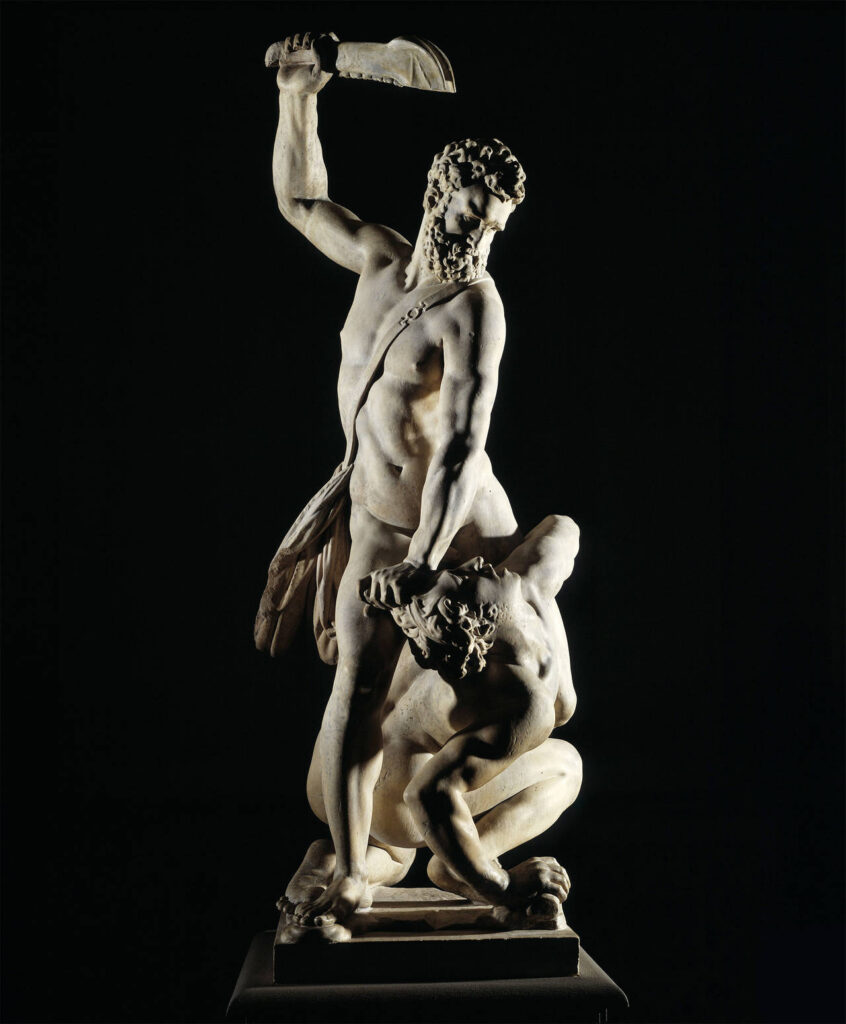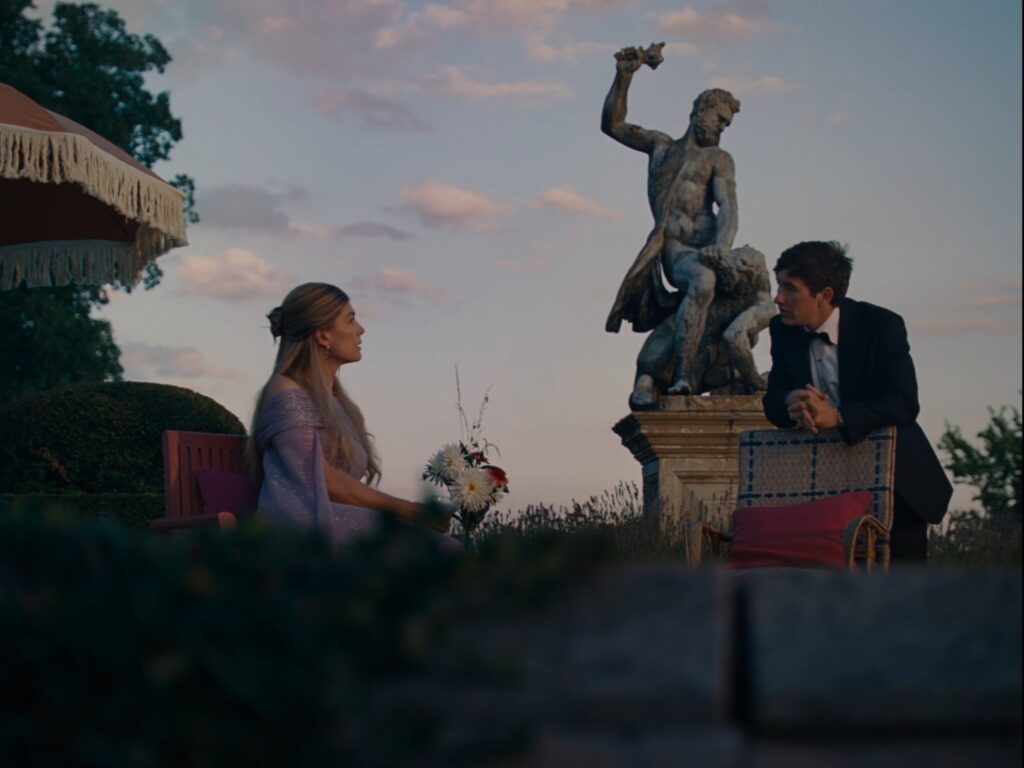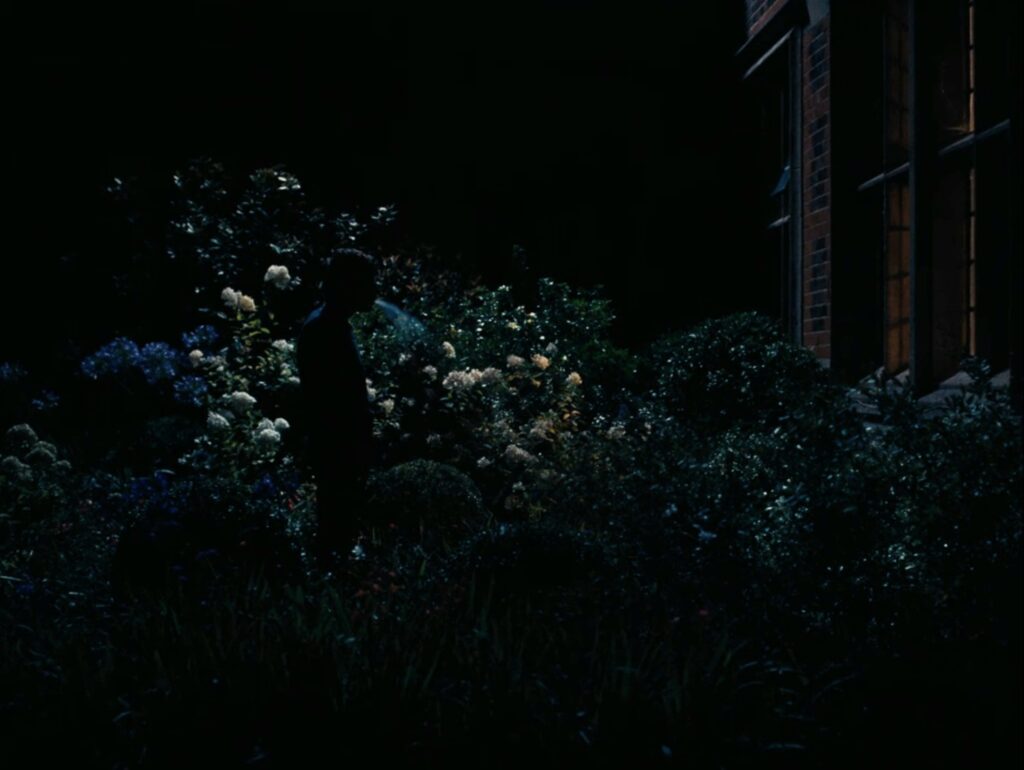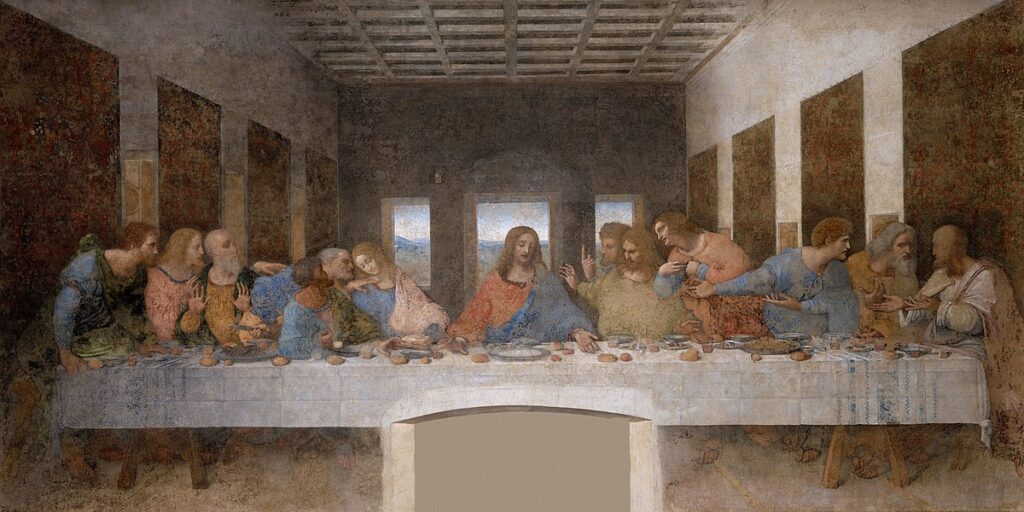Summary
- Saltburn is a new, widely watched movie which uses art as more than just a backdrop. Art supports the story that is being told in the movie.
- It features Drayton House as a symbol of nobility, Palissy’s Plates – rare and luxurious items, every collector desires, and the Samson Slaying a Philistine sculpture – morbid foreshadowing of things to come.
- Among the artistic inspirations behind Saltburn are Caravaggio’s dramatic tenebrism, Gainsborough’s portraits immersed in nature, Renaissance harmony and composition, the hedonist landscape of The Garden of Earthly Desires, and the opulence of Dutch still lifes.
What is Saltburn?
Emerald Fennell’s new movie Saltburn came out in November last year and has gained more popularity since its release on streaming sites in December. The film tells the story of Oliver, who meets a boy at Oxford University. Felix is a popular British upper-class student who invites his new friend to his family’s estate. Things escalate from there as we watch a story of obsession and desire unfold.

Poster for the movie Saltburn, directed by Emerald Fennell, 2023. Instagram. Detail.
Shot in a 1.33:1 (4:3) ratio, the film deviates from the current standard in cinema. The square-ish shape resembling a canvas transforms each frame into a visual masterpiece. Such a seemingly meaningless choice creates the feeling of a painting. Fennell’s attention to detail not only produces aesthetically pleasing scenes but also adds depth to the narrative. Let’s take a look at how art in Saltburn was used to support the story.
Art Seen in Saltburn
The Estate
The setting lets the viewer submerge into the story. Saltburn begins with a shot of the stunning Radcliffe Camera: a Baroque circular library at Oxford University. From the very beginning, we are welcomed by the grandness and excessiveness of English Baroque. The splendor follows us as the setting changes from the world of academia to the sunny mansion in the English countryside. That is when we truly understand the wealth of Felix’s character. We enter the world of the English nobility. The majority of the film was shot in Drayton House: a medieval mansion included in the National Heritage List of England.

Drayton House, Northamptonshire, UK. Photograph by Chiabella James. Architectural Digest.
The estate in the film is not just a backdrop; it is a character in itself. Dating back to the 14th century, this manor underwent a series of alterations as years went by. This created a blend of many architectural styles including Tudor, Elizabethan, and Baroque. Similarly to other medieval mansions, it was originally fortified, resembling a castle; designed on a rectangular plan with a wide symmetrical facade. These types of country houses were a symbol of status in England. The choice of such a mansion proudly showcases the family’s status as English nobility. The estate isn’t just a house; it’s a statement, a symbol of opulence.
The director decided on this location, as it has never appeared on film before. It is not a place the audience can recognize. At the same time, it looks lived in. Indeed, it is filled with expensive art, but it isn’t displayed like in a museum. We get a glimpse of the mansion’s rich interior as Felix takes us on a tour. Each room is adorned with priceless art including, as he puts it, “some hideous Rubens.” For a regular person, this interior is breathtaking and unattainable. For the family, it is simply their home.
Palissy’s Plates
Questions one may have after watching Saltburn are: who is Palissy? What are his plates? And why are they so important? Palissy’s plates play a significant part in the movie. They are a prized possession of the Catton family.

Follower of Bernard Palissy, Platter, c. 16th century, Metropolitan Museum of Art, New York City, NY, USA.
Bernard Palissy was a French ceramicist from the 16th century. Though unsuccessful in his mission to imitate Chinese porcelain, Palissy developed a unique style of rustic pottery. He created three-dimensional oval dishes decorated with molds of small animals and plants. This new and intriguing style gathered many followers. Unfortunately, the lack of Palissy’s signature on any of his works makes it difficult to distinguish his workshop from others. That is precisely why his authentic platters are so valuable. In the movie, the Catton family owns an authentic Palissy platter, which once again proves their unattainable wealth. Thus, it comes as no surprise that they would react in such a harsh way to the news that their relative tried to sell their priceless Palissy plate.
Samson Slaying a Philistine
Among all the art in Saltburn, another noteworthy artwork appears in the garden scene. Here, Oliver talks with Elspeth sitting next to a statue resembling Giambologna’s Samson Slaying a Philistine.

Giambologna, Samson Slaying a Philistine, 1560–1562, Victoria and Albert Museum, London, UK.
The original sculpture reached England in the 17th century and quickly became the most famous Italian sculpture in the UK. British sculptors inspired by this Renaissance piece began producing copies of the artwork. Affluent society funded their creation to decorate the gardens of their country houses. It is unclear whether the estate already had a copy in the garden or if it was placed there for the movie. However, the choice to shoot a scene in front of it was intentional. The dynamic composition of the sculpture shows two men in combat. One is stretching his arm with a jawbone in his hand, ready to slay the other kneeling beneath him.

Movie still from Saltburn, dir. Emerald Fennell, 2023. Prime Video.
In front of the statue sits Oliver. At that point in the movie, his true colors slowly start emerging in the unfolding narrative. Beside him is Elspeth captured by his deceit. The statue becomes more than a mere set piece. It alludes to Oliver’s future actions towards the family. Even the stance he takes during his final scene with Elspeth mirrors the pose of Samson. The sculpture appears during a turning point and foreshadows the new version of Oliver we’re about to uncover.
Artistic Inspiration Behind Saltburn
Emerald Fennell talked in an interview about the influence art had on her film. She brought attention to certain scenes that were inspired by artists such as Caravaggio and Gainsborough, or even by an entire movement like Renaissance. It comes as no surprise that the film feels like a painting when many shots remind us of artworks we have already seen. Let’s look at the possible inspirations and compare them to the movie.
Caravaggio

Caravaggio, The Calling of St. Matthew, 1599-1600, San Luigi dei Francesi, Rome, Italy.
Caravaggio was an Italian Baroque painter whose influence is clearly visible throughout the film. In 17th-century Italy, his unique style started a new trend that gathered many followers. Its most characteristic feature is the dramatic use of light. This technique is called tenebrism. The light usually comes from a singular light source. As a result, it brings focus to the illuminated subject and gives the painting a dramatic effect. Primarily, Caravaggio painted people in scenes of struggle and violence. He mastered the art of storytelling in a single frame. Even the paintings with a singular subject had a notable narrative behind them.

Movie still from Saltburn, dir. Emerald Fennell, 2023. Prime Video.
Emerald Fennell brought up one scene in particular as an example of Caravaggio’s influence on her work. It is the Karaoke scene, which certainly shows the resemblance to Baroque paintings. This group scene uses a strong contrast between light and shadow. In Caravaggio’s scenes, the light comes from a window or a candle; here, the source of light is the Karaoke machine. The Saltburn director wanted to achieve this dramatic effect of a Baroque painting, simultaneously adding a modern-day twist. Every figure poses like they are in a timeless portrait. It feels like a beautiful painting, but the tacky elements make it more human. Naturally, this is not the only scene with such a dramatic contrast of light and dark. The influence of Caravaggio’s dramatic tenebrism with modern nuances weaves throughout the film.
Thomas Gainsborough
Another artist Fennell mentioned as her inspiration was Thomas Gainsborough. Undoubtedly, he is one of the most important British artists of the 18th century. Gainsborough’s most beloved subject was landscape. However, he quickly abandoned landscape painting in favor of portrait painting. After all, landscapes from unknown artists don’t sell as well as portraits. He began painting the middle class in Suffolk and later moved to Bath to pursue a more affluent clientele.

Thomas Gainsborough, The Blue Boy, c. 1770, Huntington Library, San Marino, CA, USA.
Painting aristocracy not only was profitable but also an easy way to establish himself in the world of renowned artists. Nonetheless, his love for landscape remained and he found a way to incorporate both. He often placed the subject in nature surrounded by trees and bushes. To do so, Gainsborough paid a lot of attention to detail and carefully studied nature. This allowed him to create unique portraits where the person became a part of the landscape, as opposed to simply using the landscape as a background.

Movie still from Saltburn, dir. Emerald Fennell, 2023. Prime Video.
Similarly to Gainsborough’s works, Fennell incorporates lots of nature into her film. In one scene the main character; Oliver, stands in front of a window. Just like in Gainsborough’s portraits, he blends with the surrounding nature. The landscape isn’t just a background. He becomes one with the scenery. Granted, the scene is much darker than most Rococo paintings. Nonetheless, it resembles Gainsborough’s later works, characterized by heightened contrast. The artist primarily painted at night with limited light source, which resulted in a more intense chiaroscuro. Drawing inspiration from Gainsborough, Fennell plays here with intense light and shadow, showcasing influences not only from his stoic portraiture surrounded by nature but also from Caravaggio’s bold tenebrism.
Renaissance

Leonardo da Vinci, The Last Supper, c.1495–1498, Santa Maria delle Grazie, Milan, Italy. Wikipedia Commons (public domain)
Renaissance is yet another period in art history, which the director of Saltburn took inspiration from. This era was all about humans and perspective. It was a time when artists started to give their works realism and dimension. They wanted to show off their skill and their understanding of perspective. As a result, more artists devoted a large portion of their paintings to the study of both the interior as well as the exterior. The architecture supported the visual narrative of Renaissance works by skillfully situating figures within a vibrant three-dimensional world. Subjects were often placed on the lower half of the painting. Doing so opened up the upper half for depictions of carefully studied linear perspective.

Movie still from Saltburn, dir. Emerald Fennell, 2023. Prime Video.
Another important thing for Renaissance artists was harmony. Therefore in large compositions, they opted for apparent central symmetry. They placed the most important subject in the middle with a relatively equal number of other figures on the left and the right, to not overpower either side.
Knowing Fennell’s attention to detail the resemblance of the dinner scene to Leonardo’s Last Supper is not coincidental. In Leonardo’s piece, the central spot takes Jesus. Immediately to his right sits Judas, who later betrays him. Similarly in Saltburn, Pamela sits in the center of the shot, with Oliver on her right. Not long after Pamela is forced to leave Saltburn and we see Oliver speaking badly about her to Elspeth, which implies his malicious intent towards her and the family. Besides the thematic resemblance, we see characteristics of Renaissance symmetry and harmony of the composition.
The Garden of Earthly Delights

Movie still from Saltburn, dir. Emerald Fennell, 2023. Prime Video.
The parallels between art in Saltburn and the Renaissance can also be seen in the scene when Oliver runs to the balcony the morning after the party. Elements such as the composition, scenery, and color scheme echo Hieronymus Bosch’s The Garden of Earthly Delights. This piece is an Early Netherlandish triptych of religious themes. Early Netherlandish paintings began before the Italian Renaissance but later adopted some Renaissance ideals and styles. Therefore artworks that coincide with the Renaissance are often categorized as both.

Hieronymus Bosch, The Garden of Earthly Delights, 1490–1500, Prado Museum, Madrid, Spain.
Besides the visual resemblance, the narration of both the painting and the scene also match. The triptych consists of Eden on the left, Hell on the right and the Garden of Earthly Delights in between them. It tells a story from the beginning of humanity, through indulgence in pleasure to the day of eternal damnation. People depicted in the central panel lose themselves in pursuit of earthly delights without thinking of what awaits them. Similarly the still from the movie depicts the aftermath of a party. Various litter scattered around reminds the viewer of the indulgence in pleasure that happened the night prior. In both these works the care-free enjoyment is followed by chaos and suffering.
Dutch Still Life

Abraham van Beyeren, Banquet Still Life, 1655, Mauritshuis, The Hague, Netherlands.
The Netherlandish art in Saltburn manifests itself also in still lifes. Around the 17th century Dutch art scene saw a huge increase in still-life paintings. That came as a result of the change of interest from religion and mythology to everyday life. Saltburn is filled with carefully arranged still lifes. It is evident in almost every scene that Fennell loves a busy composition with lots of detail. The splendor of these compositions bears a close resemblance to the still-life paintings of the Dutch Golden Age. Artworks in the 17th-century Dutch Republic featured an array of objects like fruits, flowers, and silverware. On top of that, the meticulously arranged table settings were displayed on a dark, almost black background, reminiscent of the coexisting Baroque. These works are renowned for their meticulous detail, symbolic richness, and masterful rendering of light and shadow.

Movie still from Saltburn, dir. Emerald Fennell, 2023. Prime Video.
Many scenes in this movie include these still-life compositions. Particularly, the dinner scene shows the influence of these works. The assortment of various silverware and other banquet objects on a dark background lit by candlelight captures the essence of Dutch still life. Additionally, Fennell also brought attention to the clutter in Felix’s room at Oxford. Similarly to the Karaoke scene, it was influenced by these highly renowned paintings, but with a modern nuance. Instead of beautiful things like fruits and flowers, these little “still-lifes” in the background are arranged using empty bottles and packs of chips.




